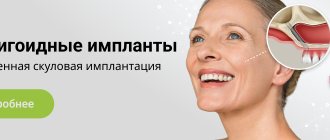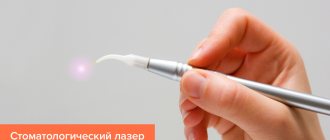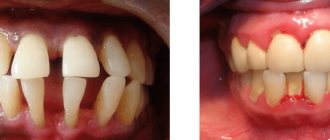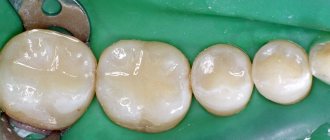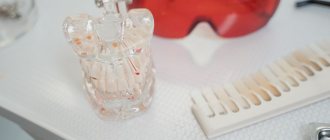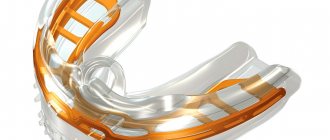847
Removing diseased teeth has always been considered a simple and effective way to get rid of the pain and discomfort they cause.
The development and manufacture of instruments for this operation was an equally important task. The first document containing information about the use of special instruments for tooth extraction dates back to the 17th century BC.
The papyrus contained images of a device similar to forceps, which could presumably be used to remove teeth.
The ancient Indian healer Sushtra divided tools for tooth extraction into forceps and special levers. The latter can be considered the prototype of modern elevators.
General overview
A dental elevator (lat. Elevator - lifting) is a hand-held dental instrument designed to remove dental roots and/or dystopic teeth by loosening and turning them out.
In terms of its action, the elevator is a classic lever and consists of 3 elements:
- working part (cheeks);
- pens;
- a long, narrow element connecting the cheek to the handle.
The cheek has the appearance of a convex-concave groove of oval, rectangular or spear-shaped. It can be symmetrical or asymmetrical, directed at different angles to the connecting part, with a mirror reflection or not.
A wide variety of shapes of the working part and its positions relative to the handle and connecting rod allows you to select an instrument that is optimally suited to perform the task facing the surgeon.
Elevators are made of chrome-nickel-molybdenum steel. Requirements for the composition and quality of the alloy are regulated by GOST 30208-94 (ISO 7153-1-88) and R 50328.1-92 (ISO 7153-1-88).
For the manufacture of elevators, steel grades B, C or D (20X13, 30X13, 45X14) are used. Tools made by powder metallurgy have the best quality. Fine steel powder containing alloying additives is pressed into a mold and sintered.
Types and purpose
Depending on the shape of the cheek and its position relative to the connecting part, the following main types of instruments are distinguished:
- straight;
- bayonet-shaped;
- angular.
The bayonet-shaped design is a subtype of the straight one. In addition to the above types, there are also special tools designed to perform more specific tasks , in particular, elevators for removing individual root fragments, wisdom teeth, etc.
Many instruments belonging to one of the above groups bear the name of their developer - Lecluse, Vint, Barry, Pott.
For what purpose is the wound filled with alvostasis with a sponge after tooth extraction and what effect does the drug have?
Come here to find out in what cases socket suturing is performed after tooth extraction.
At this address https://www.vash-dentist.ru/hirurgiya/udalenie-zubov/stomatologicheskogo-shovnogo-materiala.html you will find an overview of suture material for dental surgery.
Straight
The working and intermediate parts of a straight elevator are located in a straight line. The cheeks can be rectangular, oval or bayonet-shaped. Their edges are usually thinned and pointed. Some have notches that increase the adhesion strength to the root being removed.
Direct elevators are used primarily for removing dental roots and dystopic teeth, including maxillary 3rd molars.
The most famous straight design was developed by Lecluse, and bears his name. The most notable features of the Lecluse elevator are the handle, attached at right angles to the connecting part, and the bayonet-shaped cheek.
In appearance, Lecluse's instrument resembles a corkscrew. Due to its considerable length and power, it is used for extraction of lower “eights”.
Angular
The peculiarity of the corner elevator is that the spoon bends in relation to the connecting part at an angle of approximately 120 °C. This makes it convenient to create leverage on the roots of teeth in various directions.
The bend can be with a right or left turn (“away from yourself” or “towards you”). The spoon may be jagged and its shape is usually oval or spear-shaped.
The corner elevator is most often used to remove individual roots and dystopic teeth. In this case, the convex part rests against the wall of the hole, and the concave part is directed towards the root to be removed.
Angular tools include Winter, Barry, and Pott elevators. All of them have a handle located perpendicular to the connecting part. These are powerful tools that allow effective luxation (Latin luxatio - displacement, dislocation) of the root and subsequent removal.
Bayonet-shaped
The bayonet elevator is a straight elevator. Its cheek is shaped like the tip of a spear, one side is smooth, the other is convex.
An example of using a bayonet-shaped instrument: with a completely destroyed crown of the 1st molar and a thick interradicular septum, it is used to separate the roots and dislocate and remove them separately.
The Lecluse elevator, which also belongs to the bayonet type, is used to remove third molars on the lower jaw. Its length and power are quite sufficient for this task.
However, you need to act carefully, since there is a danger of dislocation of the neighboring teeth on which the instrument rests.
To remove root fragments
To remove separated roots or fragments thereof, it is convenient to use instruments with very thin cheeks, sometimes located on both sides of the instrument and in different directions to each other (“away from you” and “towards you”). The surgeon holds such an instrument in the “writing pen” manner.
When is root removal required?
It happens that only the root remains in the gum, and its crown part has been completely lost due to mechanical stress or untreated caries. After an X-ray examination, CELT specialists determine the possibility of treating such roots and their further use as a support for the crown. If this is not possible and the tissue surrounding the root is changed, a decision is made to remove it. Indications for root removal of front, broken, baby and other teeth are:
| Indications | Reasons for deletion |
| Serious damage to the crown of the tooth | Complete fracture of the crown, complex transverse fracture, fracture along the lobar axis, as well as destruction of the tooth crown below the gum level |
| Inflammatory processes | Development of inflammation in the root area in the form of a cyst, granuloma, abscess or phlegmon |
| Dentofacial anomaly | The tooth that is to be removed has an atypical location and prevents other teeth from growing, injures the gums and causes discomfort |
| Movable root | Third degree of tooth mobility |
It is worth noting that the crown part of the tooth can be destroyed both on a tooth with a nerve and on a pulpless tooth. If the tooth is “alive” and the destruction of its coronal part is not severe, its preservation is quite possible. As for a tooth with a removed root, the latter, as a rule, are seriously damaged and their restoration is quite difficult. In this case, the doctor may recommend removal of the tooth root and subsequent implantation.
Important nuances when working with the tool
The success of elevators in root removal depends critically on the correct choice of tool and its proper use.
Before choosing a tool, a careful examination of the root and tooth to be removed is carried out. First of all, the strength of the crown is assessed, whether it can withstand the pressure of the forceps.
If there is reason to doubt this, select an elevator design that best suits the task ahead. To prevent the crown from interfering with work, it is bitten off.
Methods of using elevators depend on the severity of the bend of the roots being removed:
- If the curvature is insignificant , the root is deflected with the tool towards the curved side, applying the load in the direction of greatest compliance. This causes the socket to enlarge and the tooth to dislocate.
- If the roots of the 3rd molars are curved medially , the crown is sectioned, an elevator is inserted from the distal side, the crown is shifted distally and removed.
- If the medial and distal roots are bent in different directions , the tooth is divided into three parts, an elevator is inserted from the side opposite to the root being removed, and the distal and medial roots are shifted in the direction of the bend. After the periodontal ligaments have ruptured, the root is removed.
- When the root is bent in the lingual or buccal direction, the elevator expands the periodontal gap in the plane of the root bend and removes it.
- Premolars with a completely destroyed crown and a significant thickness of the alveolar process are removed by inserting cheek counters between adjacent teeth and the roots of the premolar.
- Direct elevators are advisable to use when removing wisdom teeth , especially if the clinical picture is accompanied by a problem with opening the mouth. The working part is located along the medial buccal surface of the figure eight.
Serious attention should be paid to sterilization of instruments. If disinfection is insufficient, transmission of infection is possible both from doctor to patient and from patient to doctor.
There is a certain method for sterilizing dental instruments, which involves performing several successive operations: soaking in an antiseptic solution, rinsing with running water, immersing in a biosol solution heated to 40°C, drying in the open air.
Easy Graft bone replacement material and its features.
In this publication we will tell you whether supernumerary teeth are always removed.
Here https://www.vash-dentist.ru/hirurgiya/udalenie-zubov/vse-tonkosti-lazernogo.html let’s take a closer look at the method of laser tooth removal.
Healing process after surgery
After surgery, the recovery period begins. The duration of its continuation is individual, as a rule, 1-2 days. In particularly advanced clinical situations, negative symptoms may persist for about 5-7 days. After a few hours, the effect of the anesthetic wears off, causing the patient to experience severe discomfort. If the pain is pronounced and does not go away on its own, experts prescribe non-steroidal anti-inflammatory drugs and analgesics.
The day after the operation, redness and slight swelling may occur in the area affected by surgical instruments. It gradually goes away on its own when the blood supply to the area is normalized. Sometimes the patient needs to take antibacterial agents (as prescribed by the attending physician).
Immediately after tooth extraction, bleeding may occur. This is due to the fact that a small bloody clot appears in the formed hole. Most often, it can be stopped in the dental chair, but for some, the hemorrhage continues for another 1-2 days. Prolonged bleeding may be due to a number of factors, such as high blood pressure or a bleeding disorder.
To avoid the appearance of hemorrhagic syndrome, it is important to strictly follow all the instructions of the surgeon. People suffering from hypertension are advised to drink motherwort tincture before tooth extraction. With its help, the functioning of the nervous system is normalized and there will be no surges in blood pressure. To monitor the healing process after surgery, you need to see a dental surgeon on days 5-7. There is usually no need to remove sutures as they dissolve on their own. To avoid complications during the recovery period, the following measures are required:
- During the first days, it is recommended to brush your teeth with a soft brush and be especially careful so as not to touch the soft tissues. This will avoid bleeding;
- You should not eat food for the first 2-4 hours. Throughout the entire recovery period, only soft foods and drinks at room temperature are recommended. Chewing on the operated side is prohibited;
- do not rinse your mouth or take baths for the first 24 hours;
- do not undergo strenuous physical activity. Such actions cause an increase in blood pressure, which can lead to hemorrhage.
Possible complications
Although complications from tooth extraction using an elevator are relatively rare, they are not only possible, but some of them can be quite serious.
Surgical dental practice notes the following complications when using elevators:
- Bleeding due to damage to large vessels.
- Damage or removal of the rudiments of permanent teeth when removing “milk jugs,” in particular, the follicle of wisdom teeth. This is facilitated by the interdental septum, which is elastic and adapts to the changeable bite.
- A puncture wound on the cheek of the tissue adjacent to the tooth being removed. The development of bleeding is dangerous if a large vessel has been damaged, for example, a branch of the carotid artery.
- Infection of a patient with a poorly sterilized elevator, development of alveolitis.
- Luxation (rupture of the periodontal ligament) of adjacent teeth due to improper use of the elevator.
- The tip of the instrument breaks off and gets stuck in the wound.
- Alveolar bone fracture. Can occur when removing buccal or medially curved roots - in cases where the load on the instrument is applied to the tips of the roots.
In dental practice, a curious case was recorded when, a month after successful tooth extraction, a granuloma formed in the area adjacent to it.
After its removal, a piece of the dental surgeon's nail was found in it, which was cut off with an elevator during root removal.
The video provides additional information on the topic of the article.
Root removal steps:
- Carrying out activities for the administration of a local anesthetic drug;
- Separation of the circular ligament from the neck of the tooth, moving the gum tissue away from the edge of the alveolus;
- Cutting the gums and drilling out the bone tissue to provide access to the root (if necessary);
- The process of removing the root using forceps or a dental elevator. If a tooth has several roots, removal is carried out in parts;
- Treatment of the hole, suturing (if the gum is cut), treatment of the operated area.
It is important to understand that removing roots located on the upper jaw is different from removing roots located on the lower jaw. In the first case, special forceps are used, in the second - elevators. The technique for removing the roots of the upper jaw involves twisting single roots and dislocating parts of one root. As for the roots of the lower jaw, they are twisted.
Reviews
Elevators are used in cases where extraction of a tooth or root for some reason (most often due to destruction of the coronal part) cannot be performed with forceps.
Despite the fact that this operation is considered more complex, the patient, thanks to anesthesia, in most cases does not experience any more discomfort than when removed with forceps.
If you had your teeth removed using an elevator, tell us what sensations this was accompanied by, were there any complications during wound healing? The comment form is located at the bottom of this page.
If you find an error, please select a piece of text and press Ctrl+Enter.
Tags: tooth extraction
Did you like the article? stay tuned
Previous article
Icone infiltration system or “liquid filling” for teeth
Next article
What is odontoma, how dangerous is it?
Complex tooth extraction: features of the procedure
Before performing a surgical intervention, the specialist prescribes the necessary diagnostic examination (instrumental and laboratory) to the patient. First, he is sent for an X-ray examination. Using this technique, it is possible to assess the general condition of the root system and clearly see the location of the tooth in the jaw. For a more detailed analysis, obtaining images of various dental structures layer by layer, computed tomography is prescribed. It makes it possible to detect in advance the factors complicating the surgical intervention, to establish the approximate time and complexity of the procedure.
Removal of a molar or premolar is always performed under the influence of an anesthetic. To avoid negative consequences, it is recommended to first visit an anesthesiologist to identify a possible allergic reaction to a particular substance. To determine contraindications (for example, exacerbation of a chronic disease), it is recommended to undergo laboratory diagnostics - a general blood test. In the absence of contraindications, they proceed to surgical intervention. The procedure and technique for implementing the removal technique are as follows:
- Conducting anesthesia. Depending on the age, neglect of the clinical case and the general physical condition of the patient, local or general anesthesia with a potent drug may be used.
- Incision of soft tissues and separation of gums.
- Sawing out a small area of bone tissue and the coronal part, sawing the septum (only if necessary).
- Gently rocking the tooth using special tools and removing it completely.
- Applying sutures to the gum area.
If the wisdom tooth is located next to the mandibular nerve, the procedure becomes a little more complicated. This is because its roots are able to surround the area of the nerve. In such a situation, the roots are divided and removed with extreme caution so as not to touch the nerve. To carry out high-quality surgical intervention, a qualified dental surgeon is required.

